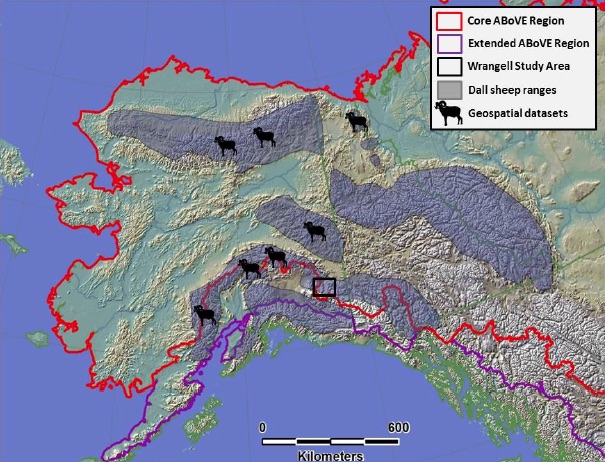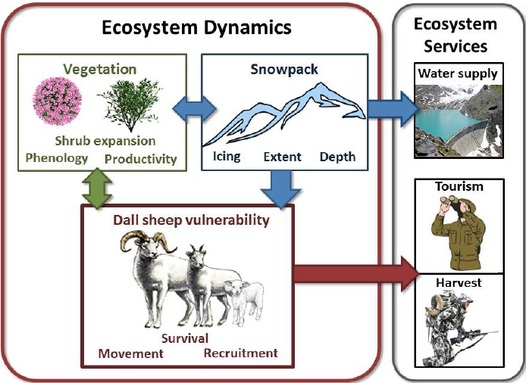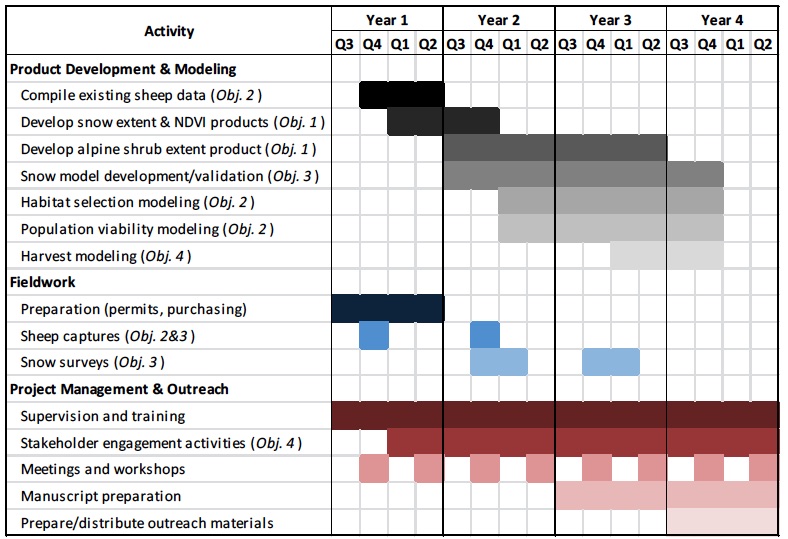Could climate change be to blame for declines in Dall sheep numbers?
Project background

Dall sheep are an ideal species to use as an indicator of alpine ecosystem health, and their range is completely contained within the ABoVE domain. As a large ungulate requiring year-round access to forage, Dall sheep may be especially sensitive to changes in habitat and snow conditions, thus functioning as a bellwether for the unique alpine community bounded by tall shrub/taiga at lower elevations and by rock and glaciers at high elevations. Unlike moose and caribou, sheep populations are isolated and may thus be less resilient to environmental change. We expect that Dall sheep and other alpine species may be affected by changes in vegetation and snowpack characteristics through a variety of mechanisms, with substantial impacts on ecosystem services:

Global climate change is driving changes in alpine vegetation and snowpack, and these changes interact with one another. Shrub encroachment reduces habitat area and connectivity and may bring predators closer to sheep. Changes in timing of alpine plant green-up and productivity affect lambing rates and body condition. Sheep rely on alpine meadows with shallow snow and may be severely impacted by deep snow, icing events, and late spring extent. Changes in sheep vulnerability will affect subsistence harvest, trophy hunting, and tourism, while changes in snowpack will affect critical water supplies for people.
Declines in Dall sheep populations throughout their range have led to emergency harvest closures and made sheep harvest by far the most contentious wildlife management issue in Alaska. Dall sheep likely function as bellwethers of alpine ecosystem health, and signs are pointing towards increasing ailment. The overarching goal of our study is to address the question: How are vegetation and snow conditions changing in alpine ecosystems throughout the ABoVE domain, and how do these changes impact iconic northern wildlife and critical ecosystem services?
Declines in Dall sheep populations throughout their range have led to emergency harvest closures and made sheep harvest by far the most contentious wildlife management issue in Alaska. Dall sheep likely function as bellwethers of alpine ecosystem health, and signs are pointing towards increasing ailment. The overarching goal of our study is to address the question: How are vegetation and snow conditions changing in alpine ecosystems throughout the ABoVE domain, and how do these changes impact iconic northern wildlife and critical ecosystem services?
Approach
Within the overarching goal of our study, we address four specific objectives:
1) Quantify changes in vegetation and snow extent in alpine ecosystems throughout the ABoVE domain from 1980-2018.
Dall sheep populations may be sensitive to shrub expansion, and to changes in show extent and alpine plant phenology. We will use a time series of Landsat TM to Landsat OLI imagery to map areas of alpine shrub expansion throughout Dall sheep mountain ranges. We will map detailed changes in alpine shrub cover in the areas of extensive shrub expansion through a comparison of orthrectified historic aerial photography and recent >0.5 meter satellite imagery from the NGA satellite fleet. We will also use the MOD10A2/MYD10A2 8-day snow cover bit to estimate the last day of snow at 500-m pixel size, and the MOD13Q1/MYD13Q1 NDVI product to estimate peak annual NDVI of alpine vegetation at 250-m pixel size from 2000-2018.
2) Assess the impact of changing snow and vegetation characteristics on Dall sheep habitat selection and population viability throughout their distribution.
Although substantial amounts of spatially-explicit data on sheep movements and demographics are available, these data have not been synthesized or linked with remote sensing products to examine region-wide trends and primary drivers of change. We will use resource selection models and geospatial location data from Dall sheep fitted with GPS and VHF collars to model movement and habitat selection as a function of vegetation, physiographic features, and bioclimatic variables. We will also use data from telemetry and surveys to estimate demographic rates and investigate how they are affected by environmental covariates. These demographic rates will then be used to parameterize a stochastic population model and predict population viabiilty under different environmental circumstances.
3) Characterize snowpack properties at a spatial scale relevant to wildlife management.
To date, remote sensing capabilities are not able to provide snowpack characteristics at spatial and temporal scales needed for wildlife management applications. To address this gap, we model the physical evolution of snow in the study region. We will use SnowModel, a state of the art, spatially distributed, multi-layer snow-evolution modeling system designed for application in all landscapes, climates, and conditions where snow occurs. We will parameterize and validate the model by collecting detailed snow and climate data in Wrangell St-Elias National Park; the largest protected area in North America and home to ~20% of the global Dall sheep population.
4) Relate our improved understanding of alpine ecosystem dynamics to the societal implications of altered sheep harvest.
A better understanding of environmental change in alpine systems and impacts on Dall sheep is needed to predict how sheep populations and harvest opportunities are changing throughout their range. This knowledge is critical for wildlife managers, hunters, and other stakeholders to effectively manage this iconic northern species. We hypothesize that late winter severity and phenological mismatch between lambing and green-up reduces recruitment and results in a negative lag effect (7-8 years) on mature male sheep (legally harvested cohort) and sheep hunting opportunities. We will test this hypothesis by compiling harvest data throughout the range of Dall sheep and constructing regression models to predict sheep harvest based on environmental variables and population trends.
1) Quantify changes in vegetation and snow extent in alpine ecosystems throughout the ABoVE domain from 1980-2018.
Dall sheep populations may be sensitive to shrub expansion, and to changes in show extent and alpine plant phenology. We will use a time series of Landsat TM to Landsat OLI imagery to map areas of alpine shrub expansion throughout Dall sheep mountain ranges. We will map detailed changes in alpine shrub cover in the areas of extensive shrub expansion through a comparison of orthrectified historic aerial photography and recent >0.5 meter satellite imagery from the NGA satellite fleet. We will also use the MOD10A2/MYD10A2 8-day snow cover bit to estimate the last day of snow at 500-m pixel size, and the MOD13Q1/MYD13Q1 NDVI product to estimate peak annual NDVI of alpine vegetation at 250-m pixel size from 2000-2018.
2) Assess the impact of changing snow and vegetation characteristics on Dall sheep habitat selection and population viability throughout their distribution.
Although substantial amounts of spatially-explicit data on sheep movements and demographics are available, these data have not been synthesized or linked with remote sensing products to examine region-wide trends and primary drivers of change. We will use resource selection models and geospatial location data from Dall sheep fitted with GPS and VHF collars to model movement and habitat selection as a function of vegetation, physiographic features, and bioclimatic variables. We will also use data from telemetry and surveys to estimate demographic rates and investigate how they are affected by environmental covariates. These demographic rates will then be used to parameterize a stochastic population model and predict population viabiilty under different environmental circumstances.
3) Characterize snowpack properties at a spatial scale relevant to wildlife management.
To date, remote sensing capabilities are not able to provide snowpack characteristics at spatial and temporal scales needed for wildlife management applications. To address this gap, we model the physical evolution of snow in the study region. We will use SnowModel, a state of the art, spatially distributed, multi-layer snow-evolution modeling system designed for application in all landscapes, climates, and conditions where snow occurs. We will parameterize and validate the model by collecting detailed snow and climate data in Wrangell St-Elias National Park; the largest protected area in North America and home to ~20% of the global Dall sheep population.
4) Relate our improved understanding of alpine ecosystem dynamics to the societal implications of altered sheep harvest.
A better understanding of environmental change in alpine systems and impacts on Dall sheep is needed to predict how sheep populations and harvest opportunities are changing throughout their range. This knowledge is critical for wildlife managers, hunters, and other stakeholders to effectively manage this iconic northern species. We hypothesize that late winter severity and phenological mismatch between lambing and green-up reduces recruitment and results in a negative lag effect (7-8 years) on mature male sheep (legally harvested cohort) and sheep hunting opportunities. We will test this hypothesis by compiling harvest data throughout the range of Dall sheep and constructing regression models to predict sheep harvest based on environmental variables and population trends.
Timeline

Year 1 = Aug 2015–Jul 2016, Year 2 = Aug 2016–Jul 2017, Year 3 = Aug 2017–Jul 2018, Year 4 = Aug 2018–Jul 2019.
